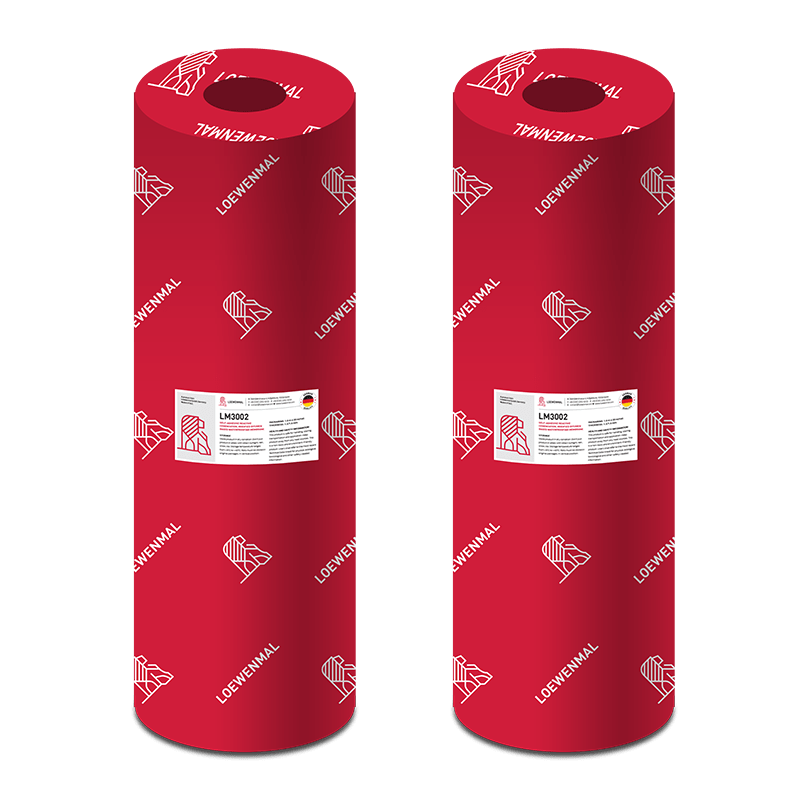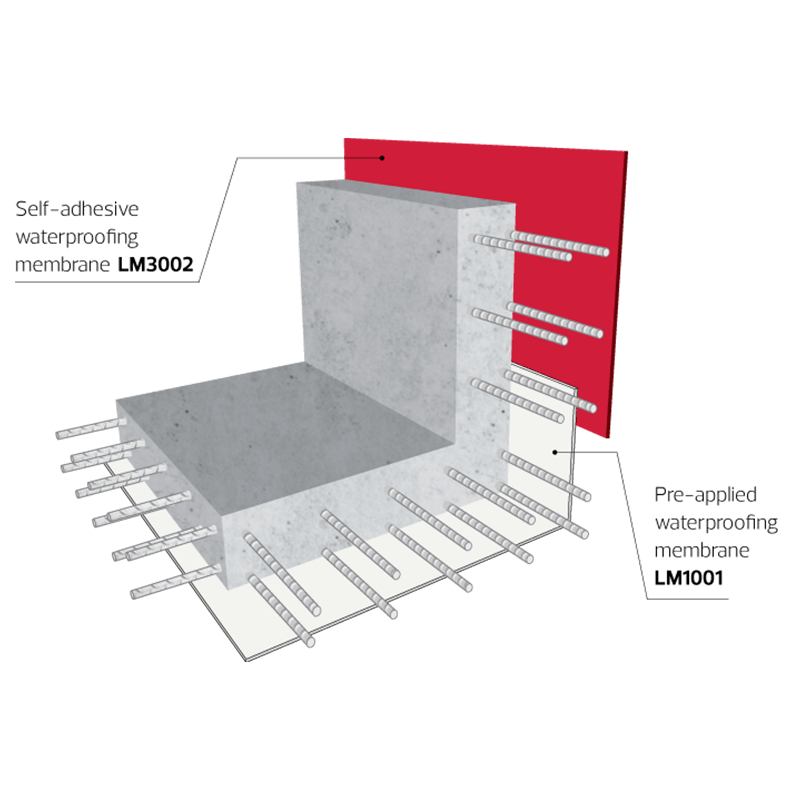Membrane

LM3002 Waterproofing Membrane
SELF-ADHESIVE REACTIVE CEMENTATION, MODIFIED BITUMEN BASED WATERPROOFING MEMBRANE
LM3002 is a high performance reactive self-adhesive cementation, modified bitumen based waterproofing membrane.
The membrane consists of a special reinforced film and layers of modified bitumen which can respond to cement slurry. LM3002 makes an efficient and durable waterproof on concrete structure that never separates from its substrate.
LM3002 is designed to use for various purposes, be it pre-applied or cold-applied.
LM3002 includes 2 types: single-sided and double-sided self-adhesive membranes.
- Dimensional stability, excellent heat resistance and low temperature flexibility
- High puncture resistance
- Accommodate to movement of concrete structure
- Automatic healing for damages with dimension D < 2 mm
- Simple installation
- Simple overlapping jointing
- No primer required
- High elongation
- Crack bridging ability
- Can be applied on dry or wet substrate
- Long lifespan
- Resistant to chemical corrosion
- Basements of buildings
- Urban tunnels
- Underground drinking water tanks
- Outside swimming pools
- Underground sewage tanks, channels
- Underground water pipelines
- Metro stations, subways
- Green roofs, roof gardens
- Non-exposed roofs
- Toilets, balconies, terraces, etc.
- Wet/damp areas
- a. Packaging: 1.0 m x 20 m/roll
- b. Thickness: 1.2 mm or 1.5 mm
| No. | Technical Properties | Testing standard | |
|---|---|---|---|
| 1 | Color | Dark/Grey | - |
| 2 | Thickness | 1.2/1.5 mm | ASTM D3767 |
| 3 | Tensile strength (CD/MD) | ≥ 3 MPa | ASTM D412 modified |
| 4 | Elongation at break | ≥ 220% | ASTM D412 modified |
| 5 | Puncture resistance | ≥ 200 N | ASTM E154 |
| 7 | Peel adhesion to concrete | ≥ 2100 N/m | ASTM D903 |
| 6 | Resistance to hydrostatic head | ≥ 65 m | ASTM D5385 |
a. Substrate preparation:
- The concrete surface must be clean, free of dirt and sharp objects.
- Surface of lean concrete must be flat, solid without gaps greater than 10 mm.
- Concrete must be sound without honeycomb or any defects.
- Construction joints must be flat. It should be reinforced following suggestion from waterproofing supplier.
- Substrate can be damp but without standing water. Standing water must be cleaned by compressed air prior to application of the waterproofing membrane.
b. Membrane application:
1. Pre-applied:
- Waterproofing membranes are placed on the lean concrete or formwork, bitumen surface facing concrete structure.
- Both long and short edges of rolls shall be overlapped a minimum width of 80 mm. Membranes are firmly sealed together by self-adhesive function with rollers.
- Clean the membrane by water. Remove the garbage, loose materials and sharp objects. Remove all standing water on the membrane.
- Remove the protected film before pouring protection mortar/concrete.
- Set rebar, cast concrete on the protection mortar/concrete.
2. Cold-applied:
- The concrete substrate must be made saturated with water before application.
- All gaps must be filled with cement mortar or using suitable methods.
- Mix cement PCB40 with water by forced mixer until it becomes a homogeneous slurry.
- Pre-determine the volume of cement, mix cement and water following water – cement ratio of 0.35 – 0.4 (by weight). Bulk cement or bagging cement can be used.
- Mixing time is 3 – 5 minutes. Mix until a homogeneous slurry.
- If the slurry starts to set, it can be remixed and use. Adding water is not acceptable.
- Use mixed slurry within 45 minutes.
- Use trowel to plaster slurry on concrete surface, the thickness of cement slurry is about 2 mm.
- Manually apply waterproofing membranes. Spread membranes on cement slurry when it’s still wet.
- Waterproofing membranes are joined by self-adhesive splice. Splice is 80 mm in both length and width.
- Use steel rollers to firmly seal the membranes together.
- This product is safe for handling, storing and application.
- Keep product away from any heat sources.
- This is a non-toxic and environment-friendly product.
- Users shall refer to the most recent Technical Data Sheet for physical, ecological, toxicological and other safety-related information.
- Store product in dry condition.
- Don’t put product in areas with direct sunlight, rain, snow, ice.
- Storage temperature ranges from +5°C to +40°C.
- Rolls must be stored in original packages, in vertical position.
- Should use sand as backfilling material.
- Waterproofing membrane must be protected from mechanical damage.
- Foam or geotextile protection layers are recommended outside waterproofing membrane.
- All technical datasheets are based on laboratory test. Actual measured data may slightly differ from specification.



